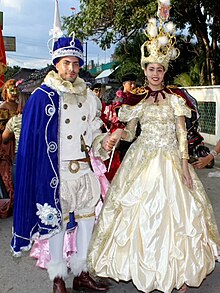
Back Carnaval en la República Dominicana Spanish Carnaval en République dominicaine French הקרנבל הדומיניקני HE

The Carnival in the Dominican Republic is celebrated in most cities and towns in the main streets of the country. Among its most notable characteristics are its flashy elaborate costumes and traditional masks. The carnival held in the city of La Vega, which is one of the biggest in the country, and the national parade in Santo Domingo, were the first Carnivals held in the Americas in the early 1500s.[1][2]

The carnival season in the Dominican Republic kicks off with a carnival gala held indoors in Santiago de los Caballeros, as opposed to every other carnival event held outdoors throughout the month of February. Dominicans are usually most festive on February 27, which is the Dominican Independence Day. In Santo Domingo, celebrations include a large military display with the Dominican air force, navy, and army. Festivities often include the wearing of colorful costumes that symbolize Dominican religious and traditional characters such as Calife, Guloya, and Diablo Cojuelo. Festivities take place all over the island, with each town adding its own twist to the celebration.[citation needed]
The timing of the festivals has grown apart from its original religious synchronization with the period of Lent. With National Independence Day on 27 February and the birthday of Juan Pablo Duarte, its founding father, on 26 January, the Carnival celebrations fill February regardless of the Lenten calendar. Traditional parades are held every Sunday throughout the month of independence in the Dominican Republic.[3]
- ^ Janette Keys. "Carnaval Dominicano/ Dominican Republic Carnival Origin". Colonialzone-dr.com. Retrieved 2016-02-12.
- ^ "La Vega se viste de carnaval; el Diablo cojuelo es el rey de la fiesta".
- ^ "Carnival". GoDominicanRepublic.com. Retrieved 2022-02-22.